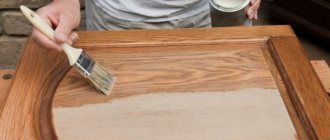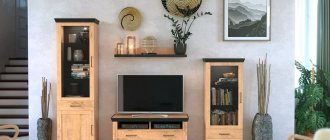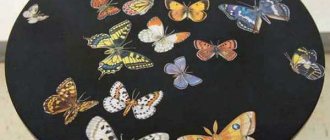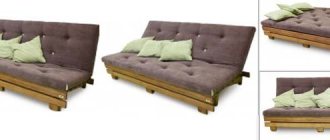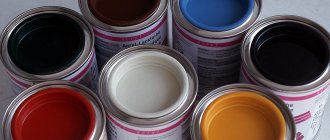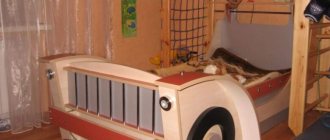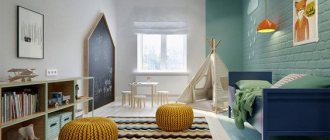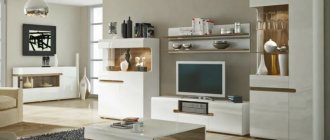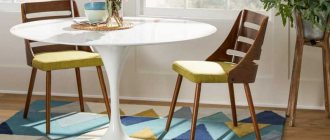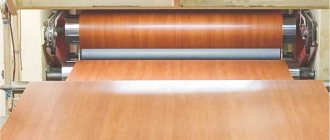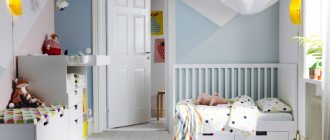Many high-quality interior items lose their attractive appearance after a long period of use. At the same time, they remain strong and reliable, therefore suitable for further use. You can improve their appearance in different ways, but the most optimal is self-adhesive furniture film, which comes in different types and is also suitable for various items. Self-adhesive film can be purchased for the kitchen or bathroom, as well as other rooms.
What is
Furniture film is a special material made from polyvinyl chloride, polyester, propylene with the addition of dyes. The fabrics are elastic, flexible, and are sold in rolls, like wallpaper. To attach to surfaces, no glue is required; you only need a pencil, scissors, and a tape measure.
Various images are applied to the front side, and an adhesive compound covered with a paper layer is applied to the back side. The protective film is not afraid of moisture, so it can be cleaned, washed, and also used in the bathroom or kitchen. Thanks to the variety of colors, patterns, textures, the material fits organically into the interior of residential and office premises, and children's rooms. The advantages of the products include:
- resistance to elevated temperatures - up to + 80 ºС;
- moisture resistance;
- ease of use;
- ease of care;
- variety of design;
- affordable price.
No special preparation is required for pasting furniture. However, you will have to be patient and perform all actions carefully, without haste. If necessary, the canvases can be easily removed and replaced with new ones.
Furniture film adheres perfectly to any surface: wood, glass, metal, plastic, ceramic.
How to apply self-adhesive film to a surface yourself
Regardless of the film chosen, there are several features of applying the material to the surface.
Table 1. Sequence of actions for self-application of film
| Work stage | Photo example |
| Before fixing the material, you should prepare the surface for work. It must be washed thoroughly. When applying film to a rough area, it should be varnished or primed. | |
| On the back of the film there is usually a grid on which it is convenient to cut the necessary elements. Mark the cut lines with a pencil and do everything with sharp scissors. | |
| To correctly paste furniture or other objects, you should read the instructions on the back of the material. Then the paper protection was removed. Apply to the base on which you are applying the design, carefully removing the layer and smoothing it to prevent the formation of bubbles. |
Everything must be done carefully and slowly, then the work will turn out well, and the surface will be smooth, beautiful and new. To make it easier to understand the nuances of the work, watch a video on the topic.
Video: applying decorative film
Varieties
All canvases are divided into protective and decorative . Using single-layer polyethylene furniture packaging films, you can prevent chips, scratches, and also minimize the negative effects of moisture. Two-layer models made of acrylic, PVC, propylene with the addition of paper, fabric and plasticizers increase the aesthetic properties of structures. Such stickers are painted in a variety of colors, decorated with all kinds of designs, patterns, ornaments, and imitate natural textures.
Special methods are used to produce self-adhesive film for furniture. For each option, special equipment is used. The two most popular technologies are:
- Molding. Products made in this way are usually used in the kitchen, are durable and easy to stick. The material does not deform under the influence of high temperatures, therefore it is used for packaging and protection from damage.
- Calendering. The canvases are easy to stick, do not shrink or deform under the influence of negative external factors. However, over time they shrink and lose their attractive appearance.
Updating interior items using a special film will be an excellent solution to prevent damage and improve the appearance of furniture. High-quality canvases have high performance characteristics and are suitable for gluing various surfaces.
Protective
Decorative
Molding
Calendered
Material characteristics
For pasting furniture, films with a polymer-based outer layer are most often used. The main materials are polypropylene, PVC (polyvinyl chloride, vinyl), polyester. The inner layer is an adhesive composition, protected from dust and dirt by a paper backing.
Modern industry offers various film options.
PVC. The material is resistant to aggressive chemicals and most external influences. Frost resistance is low, but it is unlikely that your apartment or house will experience cold temperatures of -15 °C. Susceptibility to ultraviolet radiation depends on the composition. To prevent “fading” in the sun, light-absorbing dyes are added to PVC.
Polyester. Polyester material, resistant to “chemistry” and mechanical stress. High fire resistance. Harmless and recyclable. The material is widely used in outdoor advertising and construction, which indirectly speaks about its characteristics.
Polyester film can be glued to furniture in the kitchen.
Polypropylene. It has the lowest density among all plastics. Abrasion resistant. Insensitive to heat (melts at 175 °C). Sensitivity to ultraviolet radiation is high, but is significantly reduced when special stabilizers are added to the material.
Note! The performance of all furniture upholstery films largely depends on additives. It is impossible to check the composition of impurities in products under domestic conditions. That is why it is worth purchasing covering film only from well-known brands.
Any furniture surface in your home can be revived using film.
In general, self-adhesive decorative films for furniture have the following advantages:
- moisture resistance;
- practicality;
- wear resistance, strength;
- does not require special care;
- immunity to temperature changes;
- resistance to aggressive chemicals, ultraviolet radiation, abrasion.
There are a variety of textures and colors on the market.
There are also disadvantages:
- Only smooth, prepared surfaces can be pasted over. Irregularities will be visually noticeable. Also, in places of defects, the gluing is weaker.
- The surface needs preparation: removing dust and dirt and, in some cases, removing the paintwork.
- It's difficult to make perfect joints. At the slightest inaccuracy, they will be too conspicuous.
- It is difficult to remove from some surfaces.
Colors and design
One of the main advantages of furniture film is a wide range of textures, colors, and images. Products can be glossy or matte, with a metallic sheen, plain or with patterns. The canvases are capable of realistically conveying almost any texture: wood, velor, natural stone, tile.
Purpose, features of basic types of furniture hinges, installation nuances
Plain and patterned
Self-adhesive film is indeed produced in a wide variety of colors, with each color represented in several shades. Monochrome options in calm colors are relevant for living rooms and bedrooms. Bright, cheerful colors will decorate children's and kitchen furniture.
In modern interiors, glossy black film is often used. She looks stylish, but needs regular care.
The lamination film is additionally decorated with patination, embossed patterns, 3D images, and holographic effects. Thanks to a wide range of color palettes, it is possible to realize the most original projects. The combined facades and details decorated in contrasting colors look interesting. Photo printing and children's drawings are popular. So, to create an unusual bedroom interior, large repeating patterns are used. And self-adhesive film for children is decorated with large color photographs, images of cartoon and fairy-tale characters.
Monochrome
With an image
3D design
Holography
Embossing
Photo printing
Matte and glossy
Matte self-adhesive film reliably protects facades from scratches, chips and other damage. These types of products are not afraid of moisture and have a long service life. An important advantage of the canvas is that dirt and stains are invisible on them. The surface does not glow or shine, which avoids glare when exposed to electric or sunlight. The models are suitable for finishing the kitchen, updating cabinets, cabinets and other pieces of furniture.
Glossy furniture film is usually used to cover kitchen units. In terms of performance characteristics, the products are no different from matte ones. As for the appearance, the surface sparkles with a beautiful lacquer sheen.
Glossy and matte PVC canvases allow you to transform standard furniture into ultra-modern, harmonizing with interiors in the style of minimalism or hi-tech.
Transparent and translucent films are used for window tinting. The products diffuse light and hide what is happening in the house from prying eyes. Stained glass and colored canvases look attractive on glass installed in furniture facades and interior doors.
Matte
Glossy
Transparent
Translucent
Mirror
To visually expand the space, a mirror film is used. It fits organically into the design of a small kitchen, living room, and looks impressive in small hallways. Inserts made of reflective surfaces are relevant for finishing wardrobes and bathroom furniture. The products visually enlarge the room and allow you to implement unusual design ideas.
With imitation of natural textures
Using self-adhesive film you can add special sophistication to your furniture. Lovers of natural interiors will appreciate canvases stylized to resemble natural textures:
- Silver, metal, gold. They are characterized by a noble shine and unusual appearance.
- Stone, leather, wood of various species. They always look luxurious and stylish. Thanks to the variety of options, you can choose the right film for any interior.
- Natural fabrics. Products that imitate delicate velor and luxurious velvet are trending. This design brings a touch of softness and tranquility to the home atmosphere. Canvases are used to decorate living rooms and bedrooms.
Self-adhesive film that replicates natural textures can be used to decorate only perfectly smooth surfaces and high-quality furniture. Only well-known manufacturers can perfectly replicate the texture of materials. It is their products that should be given preference when choosing.
Children's film will be an original and practical addition to the interior. It is made from a special material on which you can draw or write, then remove marker marks without compromising the integrity of the canvas.
Silver
Gold
Metal
Stone
Leather
Tree
Textile
Useful tips for choosing for different rooms
In order for furniture film to serve for a long time and not lose its attractiveness, you need to check the quality of the product, and also take into account the characteristics of the premises in which it will be used. Products for the kitchen and bathroom deserve special attention. Useful recommendations to help you make your choice:
- In the living room or bedroom, canvases are used that harmoniously fit into the interior. At the same time, it is not at all necessary to repeat the old colors of the furniture; you can cover the surface with a film decorated in other colors. In well-lit rooms, matte beige or brown canvases look beautiful; imitations of natural wood are popular.
- For finishing the kitchen space, acrylic film is suitable, which is not afraid of moisture, sunlight, and withstands mechanical stress. Imitations of natural materials, as well as red, green, brown, and white glossy surfaces, look beautiful. Many designers actively use products with photo printing and bright designs.
- Materials depicting your favorite fairy tale and cartoon characters will help refresh your children's room. The canvases are glued to bedside tables, tables, and cabinets. It is important that the child likes the pictures.
- In small corridors, film with a better perspective look looks impressive. Images of arches, doorways, landscapes, ponds and other architectural forms that add additional volume are suitable. Narrow corridors will become visually wider with mirror panels.
- Vinyl sheeting, which is used in conditions of high humidity, will help to update bathroom furniture. To treat the facades of cabinets and cabinets, a colored film that harmonizes with the shade of the walls or ceramic tiles is suitable.
Updating the interior with recessed furniture lamps
When choosing a suitable variety, it is worth considering what surface it will be located on. For antique furniture, transparent options are used to hide small scratches and abrasions . At the same time, the canvases do not change the color of the products or the appearance of the wood structure. Mosaic patterns are suitable for decorating glass.
Wenge-colored film is often used to decorate furniture facades; it is relevant for window sills and tabletops.
Living room
Bedroom
Kitchen
Children's
Corridor
Bathroom
Nuances of use
Pasting furniture with self-adhesive film is a simple process, but you need to take into account some important nuances:
- To cover small elements, you can use the dry gluing method. If you plan to treat large areas, you cannot do without covering them with moisture. Even if the film is not glued for the first time.
- When calculating the footage of purchased material, it is better to choose the width with a margin, so that if the canvas is skewed, you do not have to redo the entire work, but simply cut off the excess.
- Do not remove the protective layer completely. First, release one corner, glue it or gradually open the adhesive base while simultaneously leveling and squeezing out air bubbles.
- Before covering furniture with self-adhesive foam, it is necessary to clean the top, doors and ends, even if the adhesive is strong.
Pasting technology
Applying self-adhesive film to furniture requires care and perseverance. Before starting the procedure, it is necessary to clarify the technology of work, options for designing corners, and connecting sheets without joints. The following tools and consumables are prepared:
- sharp stationery knife;
- scissors;
- tape measure or ruler;
- the furniture film itself;
- alcohol or solvent for degreasing;
- roller for removing air from under the material;
a piece of soft cloth, a plastic spatula or an unnecessary credit card - for smoothing the canvas
If the surface of the furniture is uneven or severely damaged, repair work will have to be carried out. To do this, you will need an acrylic primer, wood putty, and medium- and fine-grained sandpaper. After eliminating the deficiencies of the facade, all actions are performed in accordance with the step-by-step instructions:
- For high-quality lamination, it is necessary to thoroughly wash the surface, dry it completely, and wipe it with a solvent.
- Measure the required length of film for wrapping furniture. To do this, you must first determine the parameters of the surface being processed, then transfer the resulting dimensions to the product.
- Cut the canvas with a small margin - 2-3 cm.
- Peel off the protective paper layer from one edge and apply the film to the furniture surface.
- Press the fabric tightly, then smooth it outward from the center.
- Do not try to glue the entire product at once. It is recommended to peel off the paper a little at a time, smoothing the surface. If the film lays unevenly, it is worth separating a piece and performing the necessary manipulations again.
At the end of the work, the self-adhesive film is wiped with a soft cloth with pressure, which ensures a perfect fit of the canvas.
To paste furniture with wooden, plywood, fabric, or plastered facades, you must first wipe the surface and remove dust from it. The service life of the canvases will be long when using putty and acrylic primer. Smooth, non-absorbent bases made of metal, plastic, glass must first be slightly moistened.
Features of using stickers on furniture, choice of materials and themes
To decorate the corners, the canvas is folded down after gluing the sidewalls. The film is cut at the corner and shortened, leaving a few millimeters of margin. The same manipulations are carried out on the second side.
To hide the joints, it is necessary to overlap one sheet over the other by about 1 cm. The stock is not glued, but remains free to lie. In the middle of the overlap, both films are cut with a sharp knife, and the resulting strips are removed. After this, the canvas is carefully smoothed. When working with textured films, the joints are almost invisible.
Solvent treatment
Measurements
Uncover
Separating the film from the protective layer
Surface pasting
Decoration of corners
Sealing joints
The finished result
Preparation for gluing
In order for the self-adhesive film to lay flat, you need to know the rules for handling it. First of all, remember that it is thin and any protrusions, depressions, or irregularities will be visible, especially on a glossy monochromatic film. Therefore, before gluing, the surface is leveled to an ideal state. If we are talking about old furniture, you can use wood putty. You can dilute regular finishing putty with PVA diluted with water (1:1). Use this mixture to seal all uneven surfaces. Just mix very small portions - literally a couple of tablespoons of powder. Try to immediately make the surface perfectly smooth - after drying it is very difficult to sand.
This is how you can use self-adhesive to change an old refrigerator
The leveled surface is cleaned of dust and dirt (with water and dishwashing detergent) and dried. Everything must be removed carefully: even drops of fat, if we are talking about changing the “image” of the kitchen set. If you use abrasive or acid-containing products, everything will need to be thoroughly removed and washed several times with water and liquid dishwashing detergent.
If the surface is loose (there are areas of putty, for example), it is better to cover it with a primer. The primer is selected according to the type of surface, taking into account the adhesive composition on the PVC film. A universal option is PVA glue. It can be slightly diluted with water and coated with the surface. Just make sure that there are no streaks or smudges left - all this will be emphasized by the film. The second primer option is acrylic. Why her? Because the adhesive on self-adhesive vinyl film has just such a base.
If the original substrate is very loose, two coats of primer may be required. After drying, check for any smudges. If everything is smooth, you can begin finishing.
How to avoid common mistakes
Self-adhesive film for furniture heats up only when decorating non-standard convex or concave facades or rounded corners. The procedure is carried out using an iron or a hair dryer. At the same time, the canvases become more elastic and fit more tightly to the base.
Heating leads to the formation of bubbles, which disappear as the material cools. Do not direct a stream of hot air at them for a long time, otherwise the film may melt. It is necessary to act according to the following principle: warming up, moving the hair dryer to the side, leveling, repeating the actions - and so on until the unevenness completely disappears.
If smoothing is done while heating, extreme caution should be used. Vinyl acquires the greatest elasticity, so after strong pressure it will form waves on the furniture.
Bubbles on the pasted film are formed as a result of the entry of air. Powerful pressure will not eliminate the defect, but may damage the canvas. The best solution is to pierce the surface with a thin needle and wipe with a soft, dry cloth.
Furniture is covered with film using special technology. The fittings are first removed, and the parts of the collapsible structures are processed separately. A correctly performed procedure will update the interior, making it more neat and aesthetically attractive.
Heating makes the film more elastic
To decorate relief surfaces you need to use a soft spatula
Use a soft cloth to smooth the film and remove bubbles.
